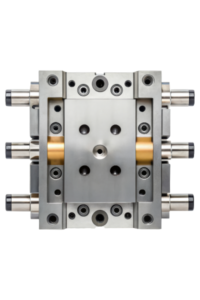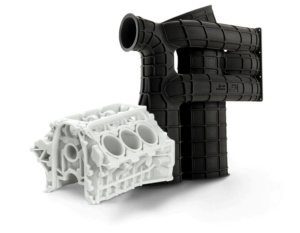Why Engineers Are Rethinking Injection Molding in 2025
The role of injection molding is evolving. Once seen strictly as a high-volume production method, it’s now a dynamic and flexible solution across the product development lifecycle. From early-stage prototyping to agile, low-volume runs for rapidly changing markets, engineers are finding new reasons to embrace injection molding in 2025. Here’s why.
This blog explores four key trends driving this shift: reshoring pressure, rapid tooling innovations, faster product cycles, and material advancements. With insights from real-world applications and support from trusted partners like Quickparts, the injection molding conversation is no longer just about scale—it’s about speed, adaptability, and competitive edge.
Reshoring Pressure Is Changing the Equation
Global manufacturing has become increasingly unpredictable. Tariffs, shipping delays, and geopolitical tensions are compelling companies to rethink overseas tooling strategies. For engineering teams under pressure to deliver parts quickly and reliably, domestic production is no longer just a convenience—it’s a strategic necessity.
By moving tooling and production closer to home, teams reduce lead times and gain more control over design iterations. Partnering with a U.S.-based manufacturer like Quickparts means engineers can skip the wait for overseas shipments and instead iterate in days, not weeks. This level of responsiveness enables teams to validate designs faster and get ahead of competitors in the high-stakes markets.
Moreover, reshoring also addresses concerns about intellectual property protection and regulatory compliance, which are crucial for industries such as aerospace, automotive, and medical devices.
Rapid Tooling Enables Faster Iteration
In 2025, the line between prototype and production is thinner than ever. Thanks to advances in aluminum and hybrid tooling, engineers can now move from CAD to molded parts in record time—without the historically high costs of steel molds.
Rapid tooling, particularly aluminum molds, has become the go-to for engineers seeking flexibility. These tools are faster to produce and modify, making them ideal for testing multiple design iterations before committing to full-scale production.
Quickparts has been at the forefront of this transition, delivering aluminum tooling solutions that help teams bridge the gap between prototype and market. In one case, Quickparts worked with a startup inventor who needed to test different handle designs for an innovative gripping device. With Quickparts’ support, the inventor leveraged aluminum tooling to evaluate function and usability with production-quality parts—ultimately accelerating their go-to-market strategy. Read full case study
Beyond speed, these tools also reduce upfront investment, making them accessible to startups and enterprises alike.
Shorter Product Cycles Demand Agility
Gone are the days of annual product updates. Product cycles have compressed dramatically in industries like consumer electronics, mobility, and healthcare. Engineering teams are expected to deliver functional, production-grade parts within months—or even weeks—of concept development.
Injection molding, once dismissed for short-run needs, is now being reimagined as a way to meet the demands of shorter cycles. With modular tooling and quick-turn molding services, engineers can mold hundreds or thousands of parts for bridge production, pilot runs, or market testing.
Quickparts’ collaboration with a medtech company preparing for FDA submission is a notable example. The client used 3D printing for early-stage functional testing and transitioned to aluminum injection molding tools to create production-representative parts for verification and limited clinical use. This approach allowed them to stay on regulatory timelines while maintaining the part quality and consistency needed for validation.
This agile use of molding ensures that market responsiveness and quality are not mutually exclusive.
Engineering Resins Expand What’s Possible
Material innovation is another driver behind the injection molding renaissance. Engineers now have access to a wide range of high-performance resins tailored to specific applications—whether for flame resistance, impact strength, chemical exposure, or biocompatibility.
With improved access to materials like PEEK, Ultem, and medical-grade ABS, low-volume injection molding production becomes more viable for critical-use applications. These resins can deliver the performance characteristics once only achievable through long-lead-time, high-cost methods.
Additionally, the availability of these materials through rapid molding services allows engineers to validate final production materials much earlier in the development cycle. This minimizes late-stage surprises and supports smoother transitions to higher-volume manufacturing.
In fact, the global injection molding materials market is projected to reach USD 397.08 billion by 2030, growing at a CAGR of 4.9% from 2023 to 2030—fueled largely by demand for advanced plastics in automotive, healthcare, and consumer applications.
Molding in 2025: A Strategic Tool Across Product Lifecycles
Injection molding is no longer just the finish line of product development—it’s a tool that supports innovation at every stage. From validating early concepts with rapid molds to reshoring production for supply chain stability, engineers are rethinking what molding can do.
Quickparts has emerged as a key partner in this shift. With the ability to support both prototyping and short-run production through in-house tooling and fast-turn molding, Quickparts enables engineers to confidently move from idea to part.
Consider this: A Quickparts automotive client working on a next-gen headlight assembly began with 3D printed prototypes to validate form and heat distribution. As the design stabilized, the team shifted to aluminum tooling to produce limited-run parts for road testing and regulatory compliance. The shift to molding enhanced material fidelity and helped the client stay ahead of evolving industry standards.
Agility is the New Advantage
In 2025, engineering will be defined by speed, flexibility, and resilience. Advances in rapid tooling, material science, and domestic manufacturing are rewriting traditional assumptions about injection molding—slow, expensive, and inflexible.
Engineers who adopt injection molding early in the product lifecycle find it to be not just a production method but a competitive advantage. The ability to produce real parts using real materials with production-quality fidelity is changing how teams innovate.
Work with a Partner Who Moves at Your Speed
Quickparts is enabling this transformation by offering rapid tooling and injection molding services tailored to engineers’ current work practices. Whether you’re refining your first prototype or preparing to launch a new product line, Quickparts provides the support, speed, and precision to help you succeed.
Ready to mold the future? Partner with Quickparts and stay ahead in 2025.


